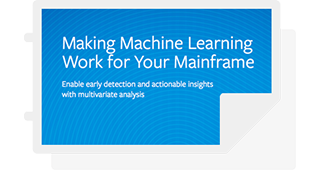When it comes to digital experiences, modern consumers are impatient. The likes of Apple and Amazon have taught them well that they can get exactly what they want in the digital realm, immediately, via their channel of choice.
While businesses are looking for ways to meet these expectations by expediting the delivery of new applications, features and services, accelerating the development process can lead to quality issues and poor customer experiences. Consider also that new technologies are continuously introduced into your environment, making it increasingly complex. Service ticket volumes are proliferating as IoT devices, APIs, mobile applications, and both digital and machine users access systems.
This onslaught of new technologies and users is yielding vast amounts of data as well, which only complicates the challenges faced by IT operations teams. As noted by Gartner, “IT operations is challenged by the rapid growth in data volumes generated by IT infrastructure and applications that must be captured, analyzed, and acted on.”
While traditional monitoring and management tools may have worked well in the past, given the complexity of today’s hybrid cloud environments, IT managers no longer have the time or bandwidth to sift through volumes of alerts to discern whether the issues they are flagging are real or not.
So how can your IT operations team continue to evolve applications and services across the environment, meeting customer expectations, maintaining performance and availability, and ensuring that strategic initiatives are supported?
AIOps Drives Innovation
An investment in AIOps can help you successfully advance your infrastructure by providing your team with the tools they need to both filter out event noise and take a more accurate and predictive approach to management and monitoring.
Powered by artificial intelligence and machine learning, AIOps solutions allow you to identify or predict potential problems before they impact business services, help with root cause analysis and then prescribe corrective actions.
AIOps tools help simplify and streamline IT operations by building models that can examine, for example, a given set of minutes on a Tuesday and compare that to a model of what historically are normal conditions for that same time period. Based on this data, AIOps tools can pinpoint anomalies and raise alerts accordingly. When overall conditions change, AIOps models can also be retrained as well.
Because AIOps solutions automate monitoring and management processes, they elevate the role of ITOps teams, allowing them to spend less time troubleshooting and more time collaborating with business units to advance their strategies and put innovation to work.
Achieving Velocity
ITOps teams remain focused on the user experience. More than any aspect of the digital experience, consumers value velocity—the speed at which the new technologies they need are developed and available to them.
However, just deploying new features, services, and applications for users is not enough. When a new application is launched, you need to ensure a quality experience for users—and slow response times are more than just an aggravation. They have real business impacts. In fact, a recent Google study cited by Forbes found that “53 percent of mobile site visitors will leave a page that takes longer than three seconds to load.”
And if your system or application goes down for users, the costs can be staggering. According to the IT Intelligence Consulting 2019 Hourly Cost of Downtime Survey, “98 percent of organizations say a single hour of downtime costs more than $100K; 86 percent report that number to be more than $300K; and 34 percent say it can cost anywhere between $1M and $5M.”
Proactively diagnosing issues is critical to elevating user experiences—especially in agile software development—and can prevent the financial bleeding that application downtime ultimately yields.
AIOps can help you meet the demand for velocity and quality. The intelligence embedded in AIOps makes future capacity planning much easier and more precise for IT operations teams. This is because the solutions can enable you to correlate analyses between business drivers and resource utilization metrics, information you can use to allocate and schedule the resources needed to support new applications.
AIOps and the Mainframe
The market for mainframe technology continues to grow according to MarketWatch, at 2.6 percent annually, suggesting that these highly secure supercomputers are as relevant today as they were decades ago.
Like many large organizations, your environment may be anchored by mainframes. However, managing the mainframe has never been more complex—in part because many organizations have failed to modernize the software tools they need to optimize the platform—and also because older generations of workers are retiring, which can mean a loss of mainframe expertise within the ITOps team.
AIOps solutions help fill in the skills gap. By modernizing and automating critical monitoring and management processes, AIOps tools allow your ITOps personnel to quickly apply their existing skills to this unfamiliar platform, detecting issues before they escalate while delivering the performance levels customers demand.
BMC’s Automated Mainframe Intelligence (AMI) Solutions
According to IDC, by 2021 70 percent of CIOs will aggressively apply AIOps to “cut costs, improve IT agility, and accelerate innovation.” Here’s why you should invest in BMC AMI solutions for your mainframe assets as you embark on this journey:
A self-managed mainframe isn’t achieved through a patchwork of disparate solutions. Instead it requires an end-to-end solution that fosters integration across the infrastructure and delivers a seamless user experience that sets the stage for business growth and technological innovation.
BMC’s AMI suite of products delivers on AIOps’ promise by:
- Applying multivariate analysis simultaneously across multiple data sources to track anomalies
- Employing predictive analytics driven by pattern analysis algorithms that detect anomalies and assess their impact
- Using intelligent automation to keep the environment running securely and at peak efficiency
- Offering built-in domain expertise so users can track the right KPIs without necessarily relying on in-house technical skills that might be scarce
Let us help you optimize all your resources, from the mainframe to the cloud. Click here to learn more about BMC AMI Operational Insight.







